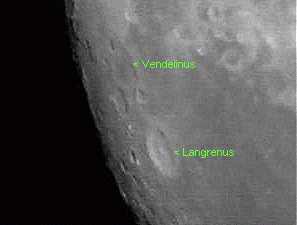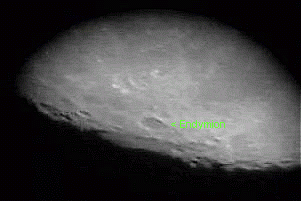Craters - 4 Days...
Langrenus:
February 5, 2003
Time: 7:50-8:30 pm EST
Seeing: 5.5 8/10
Binoculars: 5X30 Tasco
Scope: 4.5 Celestron Reflector
Eyepiece: 25mm Celestron SMA
Comments: Langrenus is a rather singularly boring crater in binoculars. It lies to the east of Mare Fecunditatis and appears shallow, with a slight lipped wall and interior peak.
Through the telescope, Langrenus gives a much better appearance. Even a such a low power, it is easy to see that the walls are eroded, and the central peak is actually two components. Accompanying it to the north is triple craters, Bilharz, Atwood and Naonobu. Small crater Somerville lies against the central east crater wall, and crater Lohse to the due south.

Langrenus (annotated) is the featured crater here, and Vendelinus (annotated) is the very shallow crater just above it.
Vendelinus:
February 5, 2003
Time: 7:50-8:30 pm EST
Seeing: 5.5 8/10
Binoculars: 5X30 Tasco
Telescope: 4.5mm Celestron
Eypieces: 25mm Celestron SMA
10mm Celestron
Comments: After getting psyched up, I started in on my craters by the book. Old friends, these are... Geminus, Masala, Endymion, Mare Crisium, Pierce, Picard, Sharp, Lick, Shapley, Livinium, Olivium, and Agarrum Promentoriums.... Taruntius, Guttenberg, Magellan, Langrenus, Vendelinus, Petavius, Funerius...
Petavius:
February 5, 2003
Time: 7:50-8:30 pm EST
Seeing: 5.5 8/10
Binoculars: 5X30 Tasco
Telescope: 4.5mm Celestron
Eypieces: 25mm Celestron SMA
12.3mm ED Epic
Comments: For binoculars, Petavius will appear to the southeast of Mare Fecunditatis as a bright ring, with a well-lit center and a very noticable bright central peak.
Now, let's scope it. At low power, the central peak is what really kicks. It gives a hint that it might be multi-structured at low power, and the walls themselves have a stadium-like effect going on. Crater Wrottsely on the northwest edge and Crater Palitzsch to the southeast are in evidence.
Ready to power up? Then discover the central peak in Petavius is indeed multi-structured. Actually, it looks like a whole mountain range with diminuative crater A to the south! This crater is very shallow... But have patience. For when a moment of perfect stability arises, there's a very special treat that is also a telescopic challenge!!
Cleomides:
February 5, 2003
Time: 7:50-8:30 pm EST
Seeing: 5.5 8/10
Binoculars: 5X30 Tasco
Telescope: 4.5 Celestron
Eyepieces: 25mm Celestron SMA
12.3mm ED Epic
Comments: Through binoculars, Cleomedes appears as a small, bright walled crater to the north of Mare Crisium.
To the telescope? Cleomedes comes alive! At low power, this crater snaps attention to an interior peak, and several small interior craters. The presence of Debes and Tralles to the northwest are perfect. Craters A and E are easily visible on the northwest wall. Interior center craters B and J are easily apparent as tiny orafices. Crater C is on the southern wall edge. Outside the slightly stepped walls to the east is crater Delmotte.
Although the use of high power is not in this excercise, please use it! For during this stage of the Moon, crater Cleomedes gives a fine treat as that interior peak is revealed as a crooked wall-like structure. Running at a diagonal across the northern portion of Cleomedes is also another beautiful feature - Rima Cleomedes. You will see it appear as a bright thread that stretches from Tralles toward Delmott, and when seeing is steady, it will also run a "Y" like branch toward interior crater J.
This one is a favourite!!

A view of Cleomides (annotated) during the later phases at lowest power.
Atlas:
Date: April 29, 2002
Scope: Celestron 4.5
Eyepiece: 25mm Celestron
Time: (no specific time listed. reports indicate late p.m.)
Comments: Atlas and Hercules, mon ami. Atlas with its' rugged mountains along the eastern rim, central peak and shallow interior craters. Hercules much stronger, with the folds along the western wall, sub-crater on the south, and a dramatic interior crater punching a hole in it's perfection.
Hercules:
Date: August 26, 2002
Scope: 4.5 Celestron
Eyepiece: 25mm Celestron
Time: (no specific time listed. reports indicate early a.m.)
Hercules: Comments: Oh, my... Where do you want to dance first? On the beauty of Atlas and Hercules... Or in the splendid shadows of De La Rue?
Date: July 27, 2002
Scope: 4.5 Celestron
Eyepiece: 25mm Celestron, 10mm Celestron
Time: (no specific time listed. reports indicate a late p.m. viewing time)
Comments: At first I am captivated by the remnants of Hercules... Gone mostly dark, it looks quite unusual without its' companion. A bright wall edge and that teasing peak to the north are all that is left. Continuing to the north, I see an odd looking ridge-like structure, and take my little flashlight out of my pocket to identify it. This is crater Gartner. Only the northern most portion of it still remains clean and defined, yet only 66 miles away its' structure looks as if it has been melted away. Upping the magnification shows a softened, barely perceptible line where a sharp crater wall one existed.

Craters Atlas and Hercules are featured in this frame.
Endymion:
February 5, 2003
Time: 7:50-8:30 pm EST
Seeing: 5.5 8/10
Binoculars: 5X30 Tasco
Scope: 4.5 Celestron
Eyepiece: 25mm Celestron SMA
Comments: To binoculars, Crater Endymion, is a smooth dark circle at the north central portion of the Moon, just west of dark grey patch, Mare Humboldtianum. It greatly resembles Plato.
To the scope at low power, Crater Endymion shows no great amount of detail. Why? Cuz' there isn't any! Like Plato, Endymion is dark floored in comparison to others. Smooth, and uninterrupted by peaks, rilles, or minor craters, the only detail to be caught in this crater is toward the southern edge where the walls are more eroded.

Crater Endymion (annotated) and surrounding features.
Macrobus:
Date: September 13, 2003
Scope: 4.5 Celestron
Eyepeice: 25mm Celestron
Time: (no specific time listed. reports indicate very early a.m.)
Comments: Mare Crisium was absolutely breathtaking. The Lavinium and Olivium Promentoriums were razor sharp. The punctuations of Pierce and Pickard intensely dimensional. Proclus, Tisserand, Macrobius, Paulus Somni, DaVinci... All capapble of supporting ridiculously high powers.
|